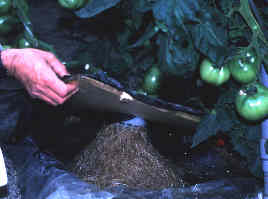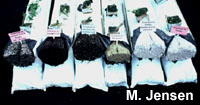

Various growing media can be used in hydroponic systems. However, any system must have the following four qualities:
- sufficient support for the plants
- appropriate distribution of air, since roots need oxygen and respire other gasses, such as carbon dioxide
- maximum water availability for the plant roots
- accessible nutrient solution with consistent chemical characteristics
 The
classic hydroponic system, where plants are supported so that
their roots hang into a nutrient solution, is generally called
"deep flow hydroponics". This system is appropriate for
hobbyists and large scale production of leafy vegetable crops.
The system consists of horizontal, rectangular-shaped tanks lined
with plastic. The nutrient solution is monitored, replenished,
recalculated, and aerated. Commercial facilities are now quite
popular in Japan. The rectangular pools act as frictionless
conveyor belts where large, moveable floats of plants (lettuce)
can be transported from transplant to harvest.
The
classic hydroponic system, where plants are supported so that
their roots hang into a nutrient solution, is generally called
"deep flow hydroponics". This system is appropriate for
hobbyists and large scale production of leafy vegetable crops.
The system consists of horizontal, rectangular-shaped tanks lined
with plastic. The nutrient solution is monitored, replenished,
recalculated, and aerated. Commercial facilities are now quite
popular in Japan. The rectangular pools act as frictionless
conveyor belts where large, moveable floats of plants (lettuce)
can be transported from transplant to harvest.
 A modification
of the deep flow system is called "nutrient film
technique", where a thin film of nutrient solution flows
through plastic lined channels, which contain the plant roots.
The walls of the channels are flexible; this permits them to be
drawn together around the base of each plant, excluding light and
preventing evaporation. For lettuce production, the plants are
planted through holes in a flexible plastic material that covers
each trough. Nutrient solution is pumped to the higher end of
each channel and flows by gravity past the plant roots to
catchment pipes and a sump. The solution is monitored for
replenishment of salts and water before it is recycled. Capillary
material in the channel prevents young plants from drying out,
and the roots soon grow into a tangled mat. This method is mainly
used for tomatoes.
A modification
of the deep flow system is called "nutrient film
technique", where a thin film of nutrient solution flows
through plastic lined channels, which contain the plant roots.
The walls of the channels are flexible; this permits them to be
drawn together around the base of each plant, excluding light and
preventing evaporation. For lettuce production, the plants are
planted through holes in a flexible plastic material that covers
each trough. Nutrient solution is pumped to the higher end of
each channel and flows by gravity past the plant roots to
catchment pipes and a sump. The solution is monitored for
replenishment of salts and water before it is recycled. Capillary
material in the channel prevents young plants from drying out,
and the roots soon grow into a tangled mat. This method is mainly
used for tomatoes.
Aeroponics is another technique, where
nutrient solution is sprayed as a fine mist in sealed root  chambers. The plants are grown in holes in panels of
expanded polystyrene or other material. The plant roots are
suspended in midair beneath the panel and enclosed in a spraying
box . The box is sealed so that the roots are in darkness (to
inhibit algal growth) and in saturation humidity. A misting
system sprays the nutrient solution over the roots periodically.
The system is normally turned on for only a few seconds every 2-3
minutes. This is sufficient to keep roots moist and the nutrient
solution aerated. Systems were developed by Dr. Merle Jensen at
the University of Arizona, for lettuce, spinach, and even
tomatoes, although the latter was judged not to be economically
viable. In fact, there are no known large-scale commercial
aeroponic operations in the United States, although several small
companies market systems for home use.
chambers. The plants are grown in holes in panels of
expanded polystyrene or other material. The plant roots are
suspended in midair beneath the panel and enclosed in a spraying
box . The box is sealed so that the roots are in darkness (to
inhibit algal growth) and in saturation humidity. A misting
system sprays the nutrient solution over the roots periodically.
The system is normally turned on for only a few seconds every 2-3
minutes. This is sufficient to keep roots moist and the nutrient
solution aerated. Systems were developed by Dr. Merle Jensen at
the University of Arizona, for lettuce, spinach, and even
tomatoes, although the latter was judged not to be economically
viable. In fact, there are no known large-scale commercial
aeroponic operations in the United States, although several small
companies market systems for home use.
 In
aggregate hydroponic systems, a solid, inert medium provides
support for the plants. As in liquid systems, the nutrient
solution is delivered directly to the plant roots. Aggregate
systems may be either open or closed, depending on whether
surplus amounts of the solution are to be recovered and reused.
Open systems do not recycle the nutrient solutions; closed
systems do.
In
aggregate hydroponic systems, a solid, inert medium provides
support for the plants. As in liquid systems, the nutrient
solution is delivered directly to the plant roots. Aggregate
systems may be either open or closed, depending on whether
surplus amounts of the solution are to be recovered and reused.
Open systems do not recycle the nutrient solutions; closed
systems do.
In most open hydroponic systems, excess nutrient solution is recovered; however the surplus is not recycled to the plants, but is disposed of in evaporation ponds or used to irrigate adjacent landscape plantings or wind breaks. Because the nutrient solutions are not recycled, such open systems are less sensitive to the composition of the medium used or to the salinity of the water. These factors have generated experiments with a wide range of growing media and the development of more cost-efficient designs for containing them.
 There
are numerous types of media used in aggregate hydroponic systems.
They include peat, vermiculite, or a combination of both, to
which may be added polystyrene beads, small waste pieces of
polystyrene beads, or perlite to reduce the total cost. Other
media such as coconut coir, sand, sawdust, are also common in
some regions of the world.
There
are numerous types of media used in aggregate hydroponic systems.
They include peat, vermiculite, or a combination of both, to
which may be added polystyrene beads, small waste pieces of
polystyrene beads, or perlite to reduce the total cost. Other
media such as coconut coir, sand, sawdust, are also common in
some regions of the world.
For growing row crops such as tomato, cucumber, and pepper, the two most popular artificial growing media are rockwool and perlite. Both of these media can be used in either closed or open systems (gravel is not recommended as an aggregate in either system). Both media are lightweight when dry, easily handled and easier to steam-sterilize than many other types of aggregate materials. Both can be incorporated as a soil amendment after crops have been grown in it.
Rockwool, or stonewool, is produced from basalt rock, and can come as spun wool, resembling fiberglass, or it can be granulated, offering an alternative to perlite and vermiculite in terms of water holding capacity and aeration. Stonewool has a high pH, generally greater than 8.0, however, it has essentially no buffering capacity, meaning it will not affect the pH of the nutrient solution nor will it affect any other media it is mixed with, such as peat moss (which has a pH of 3.8 to 4.5). Stonewool can be purchased in prepackaged "slabs"(commonly 15 x 7.5 x 100 cm long), ready to use, or as bulk granules for those growers who wish to mix their own soilless media.
Perlite is usually bagged in opaque white bags with drip irrigation tubes at each plant and drainage slits in the bags. Perlite is an inert media providing excellent aeration and water holding capacity. As in rockwool, it can be steam sterilized, rebagged and reused several times.
When both perlite and rockwool are used as closed systems, great care must be taken to avoid the buildup of toxic salts and to keep the system free of nematodes and soilborn diseases. Once certain diseases are introduced, the infested nutrient solution will contaminate the entire planting. In addition to the common practice of sterilizing the recirculating solution, there is current research exploring the use of surfactants to control certain root diseases. Such systems can be capital intensive because they require leak proof growing beds as well as subgrade mechanical systems and nutrient storage tanks.